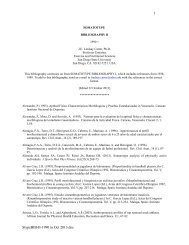THE HEATH-CARTER ANTHROPOMETRIC ... - Somatotype.org
THE HEATH-CARTER ANTHROPOMETRIC ... - Somatotype.org
THE HEATH-CARTER ANTHROPOMETRIC ... - Somatotype.org
Create successful ePaper yourself
Turn your PDF publications into a flip-book with our unique Google optimized e-Paper software.
<strong>Somatotype</strong> Instruction Manual 12<br />
The recommended procedures for obtaining and analyzing somatotype data are presented below, but all<br />
are not appropriate for every study. The listing can be used as a guide. In general, the whole<br />
somatotype (i.e. global or Gestalt somatotype) should be analyzed first. If there are differences between<br />
groups, analysis of the components should follow.<br />
1. Anthropometry. Obtain the 10 body measures needed for calculating the anthropometric<br />
somatotype. Take repeated measures to determine the technical errors of measurement, both for the<br />
measurers and for comparisons with a criterion anthropometrist, and report them. Use error<br />
detection methods when appropriate.<br />
2. Rating form and equations. Calculate the somatotype by entering the measures onto the rating<br />
form, or into the equations. The rating form should be used for beginners, for individual assessment<br />
and counseling, and for checking the pattern of measures in unusual somatotypes. Once data are<br />
entered into equations some errors are likely to go undetected. However, once proficiency is<br />
obtained in measurements, the use of equations in calculators or computers is obviously the most<br />
efficient way to handle large collections of data.<br />
3. Somatocharts. Plot individual and mean somatotypes on a somatochart. The somatoplots on the<br />
somatochart provide an important visual display, either for individuals or means, and should be<br />
utilized routinely. The shape of the distribution of somatoplots of a sample imparts considerable<br />
useful information and should be preliminary to, or accompany, statistical analysis. It is vital to<br />
interpreting results and should be included in publications when possible.<br />
4. Categories. Determine the frequencies of somatotypes in categories, e.g. balanced ectomorph,<br />
endo-mesomorph. When there are low frequencies in adjacent categories on the somatochart they<br />
can be combined for a better summary and analysis. Caution must be used in combining categories -<br />
they must make biological as well as statistical sense.<br />
5. Descriptive statistics. Calculate and report descriptive statistics for the sample variables, including<br />
endomorphy, mesomorphy, ectomorphy, SAM and SDM, as well as age, height, weight, and the<br />
height/weight 1\3 . For statistical purposes, report individual and mean somatotypes to one decimal<br />
place, e.g. 2.4-4.1-3.6. but for simplicity in conversation and written summaries round the rating to<br />
the nearest half-unit, i.e. 2½-4-3½. Standard deviations can be reported to two decimals.<br />
However, do NOT report the standard deviations within the three-number somatotype rating as this<br />
destroys the concept of the whole somatotype. For example, try to avoid writing that the<br />
somatotype of the groups was 2.4 (±0.5), 4.1 (±0.7), 3.6 (±0.6); in tables put the standard<br />
deviation under the mean, not in the next column. Sometimes a certain form might be desirable or<br />
required by editors.<br />
6. Comparative statistics. Determine what comparative statistics are needed, e.g. non-parametric<br />
and parametric. The choice of procedures will depend on consideration of the usual limitations of<br />
subject and sample characteristics, as well as the statistical assumptions and design.<br />
3/19/2003




